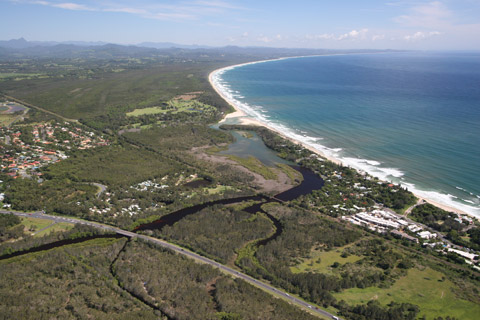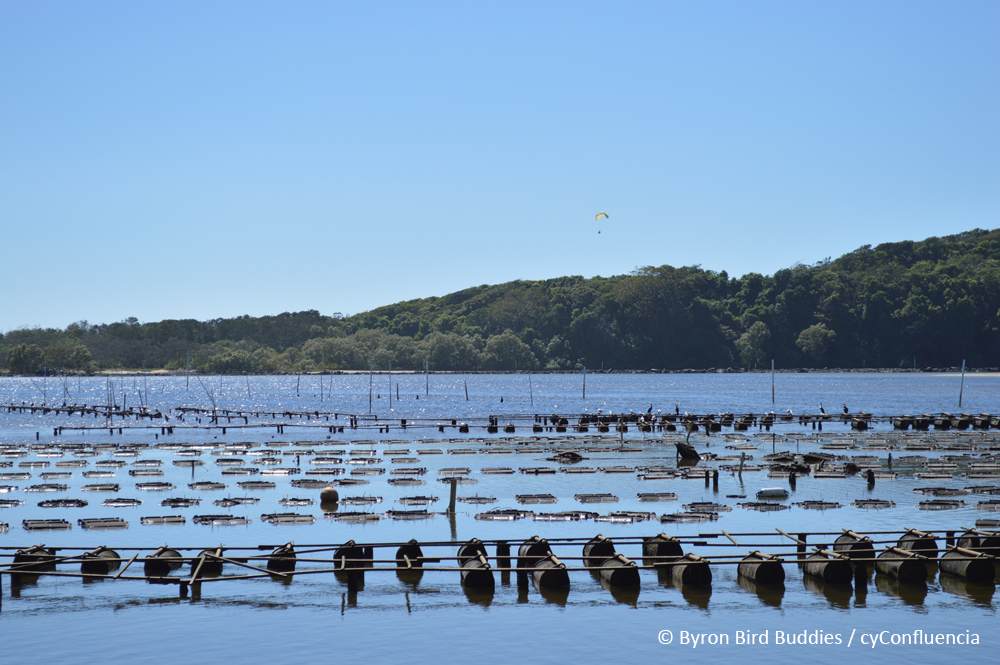 The area from Lennox Head to the high water mark in Marshalls Creek in the Brunswick River forms part of the Cape Byron Marine Park. To the north of Byron Bay is Brunswick Heads, the beautiful Brunswick River and Marshalls Creek at low tide. Tallow Creek, just to the south of the Byron Bay lighthouse. About 20 minutes to the south of Byron Bay is Lennox Head, a breeding area for the Sooty Oyster-catcher and a great surfing location. For more information go to: www.mpa.nsw.gov.au
The area from Lennox Head to the high water mark in Marshalls Creek in the Brunswick River forms part of the Cape Byron Marine Park. To the north of Byron Bay is Brunswick Heads, the beautiful Brunswick River and Marshalls Creek at low tide. Tallow Creek, just to the south of the Byron Bay lighthouse. About 20 minutes to the south of Byron Bay is Lennox Head, a breeding area for the Sooty Oyster-catcher and a great surfing location. For more information go to: www.mpa.nsw.gov.au
Aerial photograph of the Belongil Estuary and adjacent West Byron Wetlands.
Belongil Estuary Byron Bay
The Belongil is a relatively small estuarine water body near Byron Bay in northern New South Wales, where runoff from the surrounding catchment of 3,000 hectares area meets the sea. For more info, click on the image below.
Tallow Creek
Tallow Creek which becomes Tallow estuary, is located on the southern side of Cape Byron Lighthouse. The beach extends for some 3kms to the south to Broken Head, it is a great surfing beach and also serves as the main beach for Suffolk Park and Tallow’s Beach residents. The creek is mostly closed to the beach, thus hosting a number of waterbirds such as Great Egrets, ducks and Black Swans. When it is open to the tides, the estuary hosts shorebirds similar to the Belongil estuary including at times, a large number of Little Terns.

The Brunswick River
Brunswick Heads is located to the north of Byron Bay. Still forming part of the bay itself, it is at the northern most part of the Cape Byron Marine Park with the township on the shores of the beautiful Brunswick River. For more info, click on the image below.
Lennox Head
Lennox Heads is known for its enormous headland, however look below where the boulders dominate the immediate landscape and you’ll find a range of shorebirds including the vulnerable Sooty Oyster-catcher.
The Sooty Oyster-catcher breeds and feeds around the Bream Hole, a unique oceanic lagoon containing very high biological diversity. Here the Sooty’s find food such as Limpits and other small crustaceans. Surfers often walk along the rocks oblivious to the proximity of the birds. At greater risk is the Sooty chick which is raised on the sand between the black rocks. Other marine plants and animals use the protected inshore reef as a retreat from high energy ocean conditions.

Two kilometers to the south of the headland is Flat Rock. Flat Rock is important because a number of shorebirds come to the rock to rest after long periods of feeding off-shore. Flocks of Little Terns and Crested Terns are commonly seen there during the breeding season. Birds need long periods of undisturbed rest after a long-haul feeding session out to sea. More common at Flat Rock are the unleashed dogs which chase the birds and disturb them time and time again.
Byron Bird Buddies takes the view that the community will respond favourably to recognition of the needs of resting birds at Flat Rock, once a range of community education measures are put in place.


